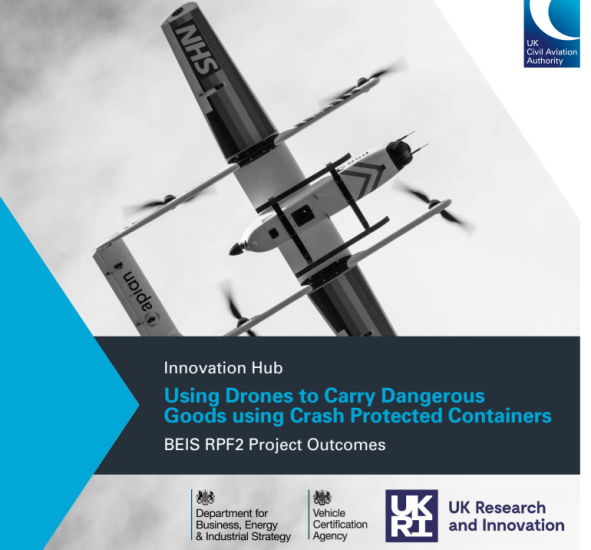The UK Civil Aviation Authority (CAA) Innovation Hub has published the project outcomes of its programme of work, started in January 2021, to identify the specific challenges experienced by the CAA and industry from the transport of dangerous goods by drone. One such challenge was how to prevent the leakage of potentially harmful substances from a drone’s cargo hold if the drone were to crash. New drone regulations, which came into effect at the start of 2021, included a reference to a “crash protected container” as one possible way to mitigate this risk, but without specifying any performance criteria or standards. Given the novelty of these regulations, there was also no international work ongoing to define the technical specifications for these specialised containers. There was therefore a need to explore exactly what the CAA would accept as being a safe crash protected container.
The CAA successfully applied to the BEIS Regulators’ Pioneer Fund (RPF) in 2021. Two projects were selected from the CAA, one of which was to establish a test regime for crash-protected containers to enable drones to carry dangerous goods.
As with any other mode of transport, the carriage of dangerous goods by UAS requires additional safety considerations, such as training for handlers and special licences for the operator.
For this project, the CAA’s proposal for the RPF was to establish a test and approval regime for crash-protected containers – special goods containers that would reduce the risk of leaks and spillage of their contents in the case of a crash.
The CAA have now published this report to describe the context, outcomes, approach, and next steps of the RPF project.
The report provides the industry with information about the test and approval regime and possible safety mitigation actions.
Outcomes and impacts of the project
- The RPAS sector has an alternative way to mitigate the additional safety risk associated with carrying dangerous goods, thereby making this type of operation more accessible for end users such as the NHS and those remote and disconnected communities across the UK.
- The industry is more informed on the risks associated with dangerous goods and in carrying them by drone, and therefore is more likely to be able to provide safe and compliant drone services.
- The industry has a formal mechanism to challenge and influence CAA policy on the carriage of dangerous goods by drone, therefore reducing the chance of regulation restricting innovation.
- The CAA has a clearer understanding of the drone dangerous goods market, enabling us to adjust policy and regulatory planning.
- Catalysing the creation of a new market in the UK and internationally for safe and compliant crash protected containers.
- The CAA is in the position to present the first proposal for technical specifications of the crash protected container to international regulatory forums, allowing the UK to be at the forefront of setting new international standards.
- UK businesses have the opportunity to be the vanguard of the international market.
Access the report here
For more information visit:




